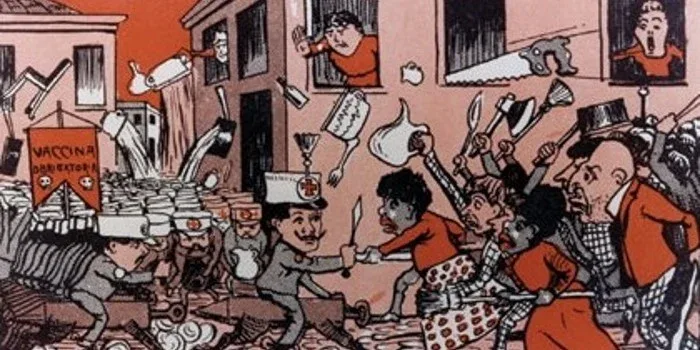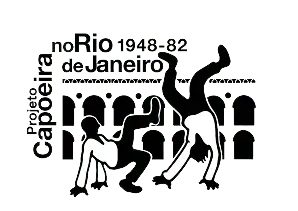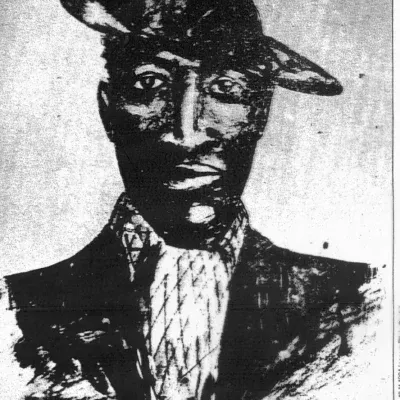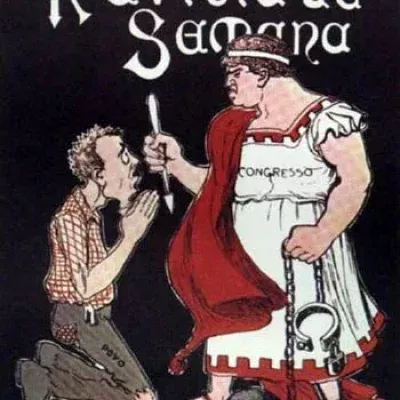By KK Bonates – Luiz Carlos de Matos Bonates

On 10 November 1904, a series of popular protests took place on the streets of Rio de Janeiro, then the capital of the Republic, challenging the compulsory vaccination against smallpox, which resulted in clashes with the security forces that lasted until 16 November. In order to contain the popular rebellion, the state of siege was decreed and the obligation to vaccinate was revoked. This social convulsion was called the “Vaccination Riot”.
This social convulsion was called the “Vaccination Riot” or the “Streetlamp Breaking ” and its official balance was of 30 dead, 110 wounded and 945 people imprisoned on the island of Cobras [a Navy headquarter in the Guanabara Bay]. The latter were then deported, if foreigners, and exiled to the north of the country, if Brazilians, mainly to Acre, at the time, a federal territory newly incorporated into Brazil.
One of the prominent figures in this revolt was the dockworker and capoeira Horácio José da Silva, known as “Prata Preta” (meaning Black Silver), who is recognised by many for his leadership in one of the main strongholds of popular resistance, the Porto Arthur barricade, located in the Saúde neighbourhood, thus named in reference to the violent battle that took place in the Russian-Japanese War (1904-1905).
The banishment of the socially undesirable to the Amazon, a distant, frontier and rustic place, dates back to the time of the Portuguese colony and extends to the first decades of the Republic. The vast majority of these undesirables were characterized as being poor, criminals or promoting social disorder.
In most cases, the treatment of undesirable “large canes”, i.e. those from the bourgeoisie, such as high-ranking military officers, influential politicians and journalists, was different from the treatment of “small canes” coming from the lower classes. As a rule, the “large cane” was prosecuted, but continued to live in his place of origin. He was first arrested, then given amnesty, and returned to public life.
The transportation of the outcasts from 1904 to Acre took place with steam-powered ships known as “Itas”, belonging to the “National Coastal Navigation Company” and hired by the Federal Government to transport the outcasts.
The prisoners were kept in the ships’ holds in promiscuous conditions and without the right to climb to the top and were watched by a strong contingent of military personnel.
The journey between Rio de Janeiro and Belém do Pará took, on average, eleven days, and between Belém and Manaus, five days. In Manaus, the deportees were transferred to regional boats of lesser draught, the “gaiolas” or barges. These boats then proceeded till the Territory of Acre and depending on their destination there, they would navigate through one of the three tributaries of the Amazon River, the Madeira, Purus or Juruá rivers. If the port of destination was Pennapolis (former Vila Empreza, now Rio Branco) or Senna Madureira, the average time of the trip was 15 days. To go to Cruzeiro do Sul, the headquarters of the Department of Alto Juruá, it was about 20 days.
Prata Preta, an undesirable “small cane”, was arrested on 17-11-1904, at 9 a.m., outside the trenches of “Porto Arthur”. He carried two revolvers, a knife and a jackknife; his body was marked with bruises caused by a sword. Legend has it that he commanded around 2,000 rebels. He was taken along with 96 other prisoners to the Snakes Island (Ilha das Cobras) to be later shipped to Acre.
There is not much bibliographic information or oral tradition on Prata Preta. The little we have comes from newspapers, magazines and almanacks of the period, which depending on their ideological stance (pro-monarchy, republican or anarchist) affirm or deny his popular leadership, making him either a hero or a villain, as the following examplea show:
Prata Preta is a man presumably 30 years old, tall, of robust complexion, completely beardless. His fame as a brave and quarrelsome man was not exaggerated, as he was seen in the most dangerous points of the trenches and barricades, shooting rifles at the attacking forces… It seems that Prata Preta was considered the General Stoessel of Porto Arthur of the Saúde neighbourhood.”
A Notícia, 16 e 17/11/1904, XI, n 271, p 1.
At great cost he was taken to the Central Police Station, being previously disarmed… he gave his name as Horácio José da Silva and was forced to wear a straitjacket, and put in jail. This black man has the nickname “Black Silver” and, for his bravery as a famous troublemaker, had been proclaimed head of the uprisings of the Saúde district.”Jornal do Commercio, 17/11/1904, n 521, p 2.
… a terrible black man, a true devil. This black, tall, muscular man, strong among the strongest, soon took on a certain supremacy, assuming the functions of chief of the dungeons. Armed with a thick piece of cable, he soon entered beating bestially, ferociously his companions in misfortune, only abandoning them when the red blood squirted from the wounds”Jornal do Brasil, 28/12/1904, p 2.
Everything was a lie, but there was still “Black Silver” there…a black! We then went to learn about the history of the celebrated Prata. Now, Prata is also keen on looting. It is not known until now which character stood out most in the famous disturbances. Prata Preta usually stops at the bars of the Conceição and Saint George streets., He is a heavy drinker, and usually gets drunk. The last conflicts have excited him, as much as he excited the little wenches, making them scream “kill”! in hysterical attacks. Our Prata Preta has never been brave.”Gazeta de Notícias, 18/11/1904, “A última ilusão”, p 2.
About the banishment of Prata Preta to Acre we find some references in newspapers that only cite the fact, but due to the partisan and ideological use of the name Prata Preta by the press and the lack of plausible supporting documentation, what remains are clues, indications and some evidence that Prata Preta was really banished and only returned to Rio de Janeiro years later.
Regarding these clues and evidence, we quote here the chronicle of Armando Sacramento “The K. Abrahão” and the description of a float in the carnival of 1905 that had as its theme the “Port Arthur” barricade of the Saúde district:
Still chased by the man with the glasses, one day K. Abraham was almost taken to Acre together with the Prata Preta. After some explanations he was thrown out and since then, in order to avoid another similar entanglement, he no longer left the scene.”O Rio Nu, 4/3/1905, edition 695, page 2.
The Port Arthur, of the Saúde district, is another float of criticism. On a wagon where one reads the inscription – Hospital of blood, there is a big cannon …covered. On the right side a red banner indicated the warrior spirit of troublesome feats under the leadership of the intrepid Prata Preta. Broken lamps surround the car, in sublime verve of democratic spirits. A guard of honour of people from Acre, carrying the axe and the mug that will regenerate them in the land of rubber.”Gazeta de Noticias, 4/3/1905, “Pepinos Carnavalescos”, edition 63, page 2.
Finally, Silva (2013) informs, without further details, that Prata Preta was exiled to Acre on December 25, 1904 and embarked on the ship Itaipava along with hundreds of other unknown deportees.
According to Bonates (2016); Bonates & Cruz (2020) the oldest documentary record of the presence of capoeira in the State of Amazonas until the date of this essay is from 1899, however, evidence indicates social behaviours related to the culture of capoeira or the action of capoeiristas at earlier dates, which can be traced back to the time of the Cabanagem Revolt (1835-1840).
Intriguing is the fact that capoeira is not mentioned in Amazonian news until the carnival festivities of February 1905, therefore soon after the arrival of the exiled. The records increase until 1920, when the rubber economic cycle collapsed and only appear again from 1972 onwards, with the arrival of Julival do Espírito Santo, the capoeira mestre Gato de Silvestre, in the middle of the economic boom of the Manaus Free Trade Zone.
The vaccine riot in the 1904 press
Cartoons on the compulsory vaccination issue
- Did Prata Preta return to Rio de Janeiro?
- Did Prata Preta stay in Manaus for some time?
- Has the passage and presence of deportees contribute to many press reports on capoeira in Amazonas state between 1905 and 1920?
- News in Rio de Janeiro newspapers reports the arrest or action of an individual, or individuals, with the nickname Prata Preta, in the years after the Vaccine Riot, e.g. 1909 and 1910. Although the name of Prata Preta referred to here is Horácio José da Silva, and that of the quote below, number 6, is Honório Manoel Leandro, it should be considered that those who did have trouble with the police used the expedient of false identification documents and false addresses to hide their true identity.
Also arrested was the well-known Saúde rioter, Honório Manoel Leandro, alias Catta Preta or Prata Preta. This guy was accompanied from the Central Station by an agent, being arrested when he disembarked in Campo Grande”O Paiz, 31/1/1909, “Eleições Federais”, page 2.
Solidary, political, inseparable friend, the moralist Dr. Barbosa Lima, like the political friend of Prata Preta, José do Senado, Camisa Preta, the heroic electoral assistant of a deputy who has horrified the public spirit with the greatest crimes.”O Paiz, 3/11/1910, “Carta Aberta”, page 3.
There is no point in making considerations again about the fact that the incorruptible and austere magistrates have verified the election held in the National Library, whose votes are still locked in the sealed ballot box and deposited the police, snatched from the bloody hands of the citizen, an electoral scavenger hunt, which goes by the suggestive nickname of Prata Preta.”O Paiz, 20/11/1909, “Conselho Municipal”, page 1.
This is where the whole programme is reduced to the case of the Council, elected by the Judges, which supported with remarkable elevation and patriotism the efforts of Prata Preta and the honourable entourage of the glorious deputy Irineu Machado, the prime contractor of the civilist Mazorca that will come to regenerate our political customs and moralise universal suffrage.”O Paiz, 07/01/1910, “Água na Fervura”, page 1.
Honório Prata Preta, and dangerous individual addicted to alcohol, entered yesterday in the bar of Rua D. Clara, n. 67, and asked the barman Raul Santos for Paraty [a rum label]. As on the night before Prata Preta had drunk and didn’t want to pay, the barman Raul denied him the drink. This resulted him receiving a fabulous hit on the head with a cudgel, administrated by the troublemaker, who, after committing this crime, retreated.”Gazeta de Notícias, 18/09/1911, “Valente Cacetada”, page 1.
- When landed in Manaus, the deportees were transferred to regional boats of lesser draught, the “cages” or “barges”. These transfers could take a few days, depending on the number of exiles and the logistics of the transportation, among others, which could increase the time spent in Manaus and raise the possibility of an escape of prisoners from the ships to the city;
- The first port city with ships suitable for the return to Rio de Janeiro was Manaus and then Belém. As the social, labour, and economic living conditions in the seringais (rubber plantations) were terrible, we can infer that many of the outcasts leaving Acre for Manaus would be in poor condition, and therefore with great difficulty to obtain work and enough money for their subsistence to make their return to Rio de Janeiro. These circumstances possibly forced many of the outcasts to choose to stay in Manaus or Belém.
- We have thus that Governor Silvério Nery in his message delivered at the opening of the 2nd ordinary session of the 5th state legislature on 10/06/1905, complains about the presence of capoeiras sent to Amazonas by the federal government in an attempt to turn the state into a prison.
- The action of capoeiragem in Amazonas, mainly in Manaus, could no longer be unnoticed and caused the governor of the State of Amazonas, Pedro Alcântara Bacelar, on 1/10/1917, in the middle of the crisis of the Rubber economy, to sanction Law number 920 that enacts the Criminal Code of the State of Amazonas. In this law, in Chapter VI, which deals with Criminal Proceedings, states in Articles 251 and 252 the following:
When the offender is sentenced as a vagrant or capoeira, the sentence will oblige him to sign terms of employment within fifteen days, counting from the completion of the sentence.” (artigo 251).
If the terms are broken, the offender will be prosecuted again according to the present Criminal Code”. (artigo 252).
Although Silva (2013) did some research for the study of the outcasts in Acre, he concludes that little is known about the misadventures of the people who were banished to Acre in the first decade of the 20th century. He also comments that there are not many records or witnesses.
In agreement with Silva, Patrícia Sampaio (2011) informs that the presence of capoeira in the Amazon can no longer be ignored. We agree with these authors and hope that this research desiderata will be extended to the northern region as a whole and emphasize, quantitatively and qualitatively, the cultural and economic contribution of convicts and other migrants in the Amazon.
The name Horácio José da Silva and the nickname “Prata Preta” (Black Silver) seem to be common at the time of the Vaccine Riot and are found between 1901-1911 in the newspapers of Rio de Janeiro referring to all kinds of people, white or black, the bailiff and the chicken thief, the knife bearer and the carnival society’s secretary, the witness of physical aggression and also the murderer.
The facts narrated here show that the controversial image of the character Horácio José da Silva, the Prata Preta, a port worker, capoeirista and black man, considered by many as a hero of the culture of the streets, deserves clarification from historiography, both in the detail of his action in the Vaccine Riot, and his life in exile and his possible return to Rio de Janeiro. The memory of capoeiragem and the popular struggles in Brazil will be grateful if this is done.

Bibliography
Bonates, L.C.M. 2016. A Capoeiragem no Amazonas (1905 a 1980) In: Capoeira em múltiplos olhares: estudos e pesquisas em jogo / Organizado por Antônio Liberac Cardoso Simões Pires e outros – Cruz das Almas: EDUFRB; Belo Horizonte. Fino Traço. Coleção UNIAFRO :13.
———- & Cruz, T.S. 2020. CAPOEIRA: o patrimônio gingado do Amazonas e sua salvaguarda. Conselho de Mestres da Salvaguarda da Capoeira do Amazonas/IPHAN, Manaus, 148p.
Sampaio, P.M. 2011. O fim do silêncio: a presença negra na Amazônia. Belém: Editora Açaí; CNPq 298p.
Silva, F.B. 2013. Acre, a Sibéria tropical: desterros para as regiões do Acre em 1904 e 1910. Manaus: UEA Edições, 326p









